Frankfurt am Main
| Frankfurt am Main | |
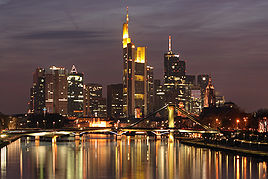 |
|
| Coat of arms | Location |
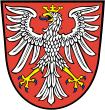 |
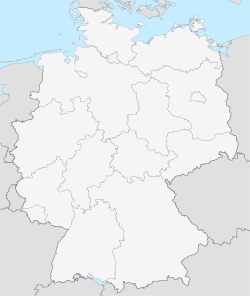 |
| Administration | |
| Country | Germany |
|---|---|
| State | Hesse |
| Admin. region | Darmstadt |
| District | Urban district |
| City subdivisions | 16 districts (Ortsbezirke) 46 boroughs (Stadtteile) |
| Lord Mayor | Petra Roth (CDU) |
| Governing parties | CDU / Greens |
| Basic statistics | |
| Area | 248.31 km² (95.9 sq mi) |
| Elevation | 112 m (367 ft) |
| Population | 670,095 (30/03/2008)[1] |
| - Density | 2,699 /km² (6,989 /sq mi) |
| - Metro | 5,800,000 (10/2009) |
| Founded | 1st century |
| Other information | |
| Time zone | CET/CEST (UTC+1/+2) |
| Licence plate | F |
| Postal codes | 60001-60599, 65901-65936 |
| Area codes | 069, 06109, 06101 |
| Website | www.frankfurt.de |
| Location of the city of Frankfurt am Main within Hesse | |
 |
|
Frankfurt am Main (German: [ˈfʁaŋkfʊɐtʰ], English: [ˈfɹæŋkfɜːt]) is the largest city in the German state of Hesse and the fifth-largest city in Germany, with a 2008 population of 670,000. The urban area had an estimated population of 2.26 million in 2001.[1] The city is at the centre of the larger Frankfurt Rhine Main Region which has a population of 5.3 million and is Germany's second largest metropolitan area. In English, this city's name translate as "Frankfurt on the Main". A large early tribe in the area was the Franks and in German "Furt" means a river crossing. Thus, in medieval times, "Frankfurt" meant the Franks' river crossing.
Situated on the Main River, Frankfurt is the financial and transportation centre of Germany and the largest financial centre in continental Europe. It is the place of residence of the European Central Bank, the German Federal Bank, the Frankfurt Stock Exchange and the Frankfurt Trade Fair, as well as several large commercial banks. Frankfurt International Airport is one of the world's busiest airports, Frankfurt Central Station is one of the largest terminal stations in Europe, and the Frankfurter Kreuz (Autobahn interchange) is the most heavily used interchange in continental Europe. Frankfurt is the only German city listed as one of ten Alpha world cities.[2] Frankfurt lies in the former American Occupation Zone of Germany, and it was formerly the headquarters city of the U.S. Army in Germany, but what is left of that organization has moved out of Frankfurt to some more remote location.
Among English speakers the city is commonly known simply as "Frankfurt", though Germans occasionally call it by its full name when it is necessary to distinguish it from the other (significantly smaller) "Frankfurt" in the state of Brandenburg, Frankfurt (Oder).
Overview


The three pillars of Frankfurt's economy are finance, transport, and trade fairs. Frankfurt has been Germany's financial centre for centuries, and it is the home of a number of major banks and brokerages. The Frankfurt Stock Exchange is by far Germany's largest, and is one of the world's most important. Frankfurt is also the seat of the European Central Bank which sets monetary policy for the Eurozone economy, and of the German Federal Bank. Over 300 national and international banks are represented including the headquarters of the major German banks.
Frankfurt has an excellent transportation infrastructure, and the Frankfurt International Airport is a major European aviation hub. Its central location at the heart of Europe and its excellent accessibility by air, rail and road make Frankfurt Airport City especially attractive.
In addition, many large trade fairs are held in Frankfurt each year, notably the Internationale Automobil-Ausstellung, the world's largest motor show, and the Frankfurter Buchmesse, the world's largest book fair.
Frankfurt is also home to many cultural and educational institutions including the Johann Wolfgang Goethe University, many museums and a large botanical garden, the Palmengarten. Frankfurt's second major university, Business School of Finance and Management, focuses on finance.
Frankfurt is one of only four European cities that have a significant number of skyscrapers. With ten skyscrapers (i.e. buildings taller than 150 m (492 ft)) in 2004, Frankfurt is second behind Paris with twelve skyscrapers, but ahead of London with eight skyscrapers and Moscow with seven skyscrapers. The city of Frankfurt contains the two tallest skyscrapers in the European Union, the Commerzbank Tower and Messeturm, which rank third and fourth on the continent after the Naberezhnaya Tower and the Triumph-Palace in Moscow.

Panorama of Frankfurt seen from the Maintower observation deck
History
In the area of the Römer, Roman settlements were established, probably in the 1st century; some artifacts from that era are found even to this day. The city district Bonames has a name probably dating back to Roman times—it is thought to be derived from bona me(n)sa. Nida (Heddernheim) was also a Roman civitas capital.
The name of Frankfurt on Main is derived from the Franconofurd of the Germanic tribe of the Franks; Furt (cf. English ford) where the river was shallow enough to be crossed by wading. Alemanni and Franks lived there and by 794 Charlemagne presided over an imperial assembly and church synod, at which Franconofurd (-furt -vurd) was first mentioned.
Frankfurt was one of the most important cities in the Holy Roman Empire. From 855 the German kings and emperors were elected in Frankfurt and crowned in Aachen. From 1562 the kings/emperors were also crowned in Frankfurt, Maximilian II being the first. This tradition ended in 1792, when Franz II was elected. His coronation was deliberately held on Bastille Day, 14 July, the anniversary of the storming of the Bastille. The elections and coronations took place in St. Bartholomäus cathedral, known as the Kaiserdom (en: Emperor's Cathedral), or in its predecessors.
The Frankfurter Messe (Frankfurt Trade Fair) was first mentioned in 1150. In 1240, Emperor Friedrich II granted an Imperial privilege to its visitors, meaning they would be protected by the Empire. Book trade fairs have been held in Frankfurt since 1478.
In 1372 Frankfurt became a Reichsstadt (en:Imperial city), i.e. directly subordinate to the Holy Roman Emperor and not to a regional ruler or a local nobleman.
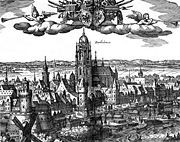
Frankfurt managed to remain neutral during the Thirty Years' War, but suffered from the bubonic plague that was brought to the city by refugees. After the end of the war, Frankfurt regained its wealth.
In the Napoleonic Wars Frankfurt was occupied or bombarded several times by French troops. It nevertheless still remained a free city until the total collapse of the Holy Roman Empire in 1805/6. In 1806 it become part of the principality of Aschaffenburg under the Fürstprimas (Prince-Primate), Karl Theodor Anton Maria von Dalberg. This also meant that Frankfurt was incorporated into the confederation of the Rhine. In 1810 Dalberg adopted the title of a Grand Duke of Frankfurt. Napoleon intended to make his adopted son Eugène de Beauharnais, already Prince de Venise ("prince of Venice", a newly established primogeniture in Italy), Grand Duke of Frankfurt after Dalberg's death (since the latter as a Catholic bishop had no legitimate heirs). The Grand Duchy remained a short episode lasting from 1810 to 1813, when the military tide turned in favor of the Anglo-Prussian lead allies, which overturned the Napoleonic order of central Europe. Dalberg abdicated in favor of Eugène de Beauharnais, which of course was only a symbolic action, as the latter effectively never did rule after the ruin of the French armies and Frankfurt being taken by the allies.
After Napoleon's final defeat and abdication, the Congress of Vienna (1812–1815, redrawing the map of Europe) dissolved the grand-duchy, and Frankfurt entered the newly founded German Confederation (till 1866) as a free city, becoming the seat of its Bundestag, the confederal parliament where the nominally presiding Habsburg Emperor of Austria was represented by an Austrian "presidential envoy".
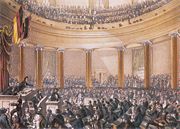
After the ill-fated revolution of 1848, Frankfurt was the seat of the first democratically elected German parliament, the Frankfurt Parliament, which met in the Frankfurter Paulskirche (St. Paul's Church) and was opened on 18 May 1848. The institution failed in 1849 when the Prussian king declared that he would not accept "a crown from the gutter". In the year of its existence, the assembly developed a common constitution for a unified Germany, with the Prussian king as its monarch.
Frankfurt lost its independence after the Austro-Prussian War as Prussia in 1866 annexed several smaller states, among them the free city of Frankfurt. The Prussian administration incorporated Frankfurt into its province of Hesse-Nassau. The formerly independent towns of Bornheim and Bockenheim were incorporated in 1890.
In 1914 the citizens of Frankfurt founded the University of Frankfurt, later called Johann Wolfgang Goethe University. This is the only civic foundation of a university in Germany; today it is one of Germany's largest universities.
After World War I, Frankfurt was occupied by French troops in reprisal for having violated, from the French viewpoint, some details of the peace treaty of Versailles concerning the demilitarisation of the Rhineland. In 1924 Ludwig Landmann became the first Jewish Mayor of the city, and led a significant expansion during the following years. However, during the Nazi era, the synagogues of Frankfurt were destroyed.
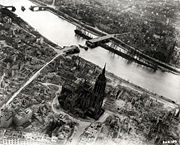
The city of Frankfurt was severely bombed in World War II (1939–1945). About 5,500 residents were killed during the raids, and the once famous medieval city centre, by that time the largest in Germany, was destroyed. Post-war reconstruction took place in a sometimes simple modern style, thus irrevocably changing the architectural face of Frankfurt. Only very few landmark buildings have been reconstructed historically, albeit in a simplified manner.
After the end of the war, Frankfurt became a part of the newly founded state of Hesse, consisting of the old Hesse-(Darmstadt) and the Prussian Hesse provinces. The city was part of the American Zone of Occupation of Germany. The Military Governor for the United States Zone (1945–1949) and the United States High Commissioner for Germany (HICOG) (1949–1952) had their headquarters in the IG Farben Building, intentionally left undamaged by the Allies' wartime bombardment. Frankfurt was the original choice for the provisional capital of West Germany—they even went as far as constructing a new parliament building that has never been used for its intended purpose. Since 1949 it is used to house the radio studios of Hessische Rundfunk. In the end, Konrad Adenauer (the first post-war Chancellor) preferred the tiny city of Bonn, for the most part because it was close to his hometown, but also for another reason; many other prominent politicians opposed the choice of Frankfurt out of concern that Frankfurt, one of the largest German cities and a former centre of the old German-dominated Holy Roman Empire, would be accepted as a "permanent" capital of Germany, thereby weakening the West German population's support for reunification and the eventual return of the Government to Berlin.

During the 1970s, the city created one of Europe's most efficient underground transportation systems. That system includes a suburban rail system (S-Bahn) capable of reaching outlying communities as well as the city centre, and a deep underground light rail system with smaller coaches (U-Bahn) also capable of travelling above ground on street rails.
Since the postwar period Frankfurt has emerged once again as the financial and transportation centre of Germany.
Population
Frankfurt is a multicultural city. Most immigrants are from Turkey, Albania, Croatia, Serbia, Bosnia and Herzegovina, Italy, Spain, North African countries, Iran, Lebanon, and the United States. The Frankfurt Area is also home to the (now 2nd) largest Korean community in Europe, and 180 different nationalities reside in Frankfurt.
For a long time Frankfurt was a Protestant-dominated city. However, during the 19th century an increasing number of Catholics moved to the city. Today a small majority of its citizens are Catholic. According to the Central Council of Jews in Germany, there are 7,300 Jews affiliated with Judaism in Frankfurt, giving it the second largest Jewish community (behind Berlin) in Germany.
Cuisine
Frankfurt cuisine is well known for Frankfurt Sausages. They are usually pink colored and are usually sold in packages with water.
Geography

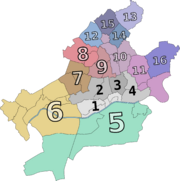
Geographic location
The city is located on both sides of the River Main in the south-west part of Germany. The southern part of the city contains the Frankfurt City Forest (Frankfurter Stadtwald), Germany's largest forest within a city. The center of Frankfurt is located on the north side of the river.
Neighbouring communities and areas
To the west, Frankfurt borders the Main-Taunus-Kreis (Hattersheim am Main, Kriftel, Hofheim am Taunus, Kelkheim (Taunus), Liederbach am Taunus, Sulzbach (Taunus), Schwalbach am Taunus and Eschborn); to the northwest the Hochtaunuskreis (Steinbach (Taunus), Oberursel (Taunus), and Bad Homburg); to the north the Wetteraukreis (Karben and Bad Vilbel); to the northeast the Main-Kinzig-Kreis (Niederdorfelden and Maintal); to the southeast the city of Offenbach am Main; to the south the Kreis Offenbach (Neu-Isenburg) and to the southwest the Kreis Groß-Gerau (Mörfelden-Walldorf, Rüsselsheim and Kelsterbach).
City divisions and districts
The city is divided into 46 Stadtteile or Ortsteile which are again divided into 118 Stadtbezirke. The largest Ortsteil is Sachsenhausen-Süd. Most Stadtteile are incorporated suburbs (Vororte), or previously separate cities, like Höchst. Some like Nordend arose during the rapid growth of the city in the Gründerzeit following the unification of Germany. Others were formed from settlements which previously belonged to other city divisions, like Dornbusch.
The 46 city divisions are combined into 16 area districts or Ortsbezirke, which each have a district committee and chairperson.
History of incorporation
Until the middle of the 19th century, the city territory of Frankfurt consisted of the present-day Stadtteile of Altstadt, Innenstadt, Bahnhofsviertel, Gutleutviertel, Gallus, Westend, Nordend, Ostend, Riederwald and Sachsenhausen. After 1877, a number of previously independent areas were incorporated into the city, see .
Main sights

St. Bartholomeus' Cathedral
|
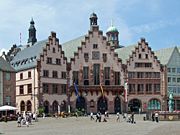
Roemer, the town hall
|
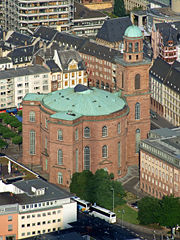
St. Paul's Church
|
|
The old opera house, now a concert hall
|
|
St. Katherine's Church
|

Maintower
|
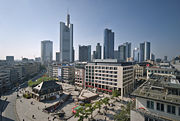
The financial district (back) and Hauptwache (front)
|
Saint Bartholomeus' Cathedral
Saint Bartholomeus' Cathedral (Dom Sankt Bartholomäus) is a Gothic building which was constructed in the 14th and 15th centuries on the foundation of an earlier church from the Merovingian time. It is the main church of Frankfurt. From 1356 onwards, kings of the Holy Roman Empire were elected in this church, and from 1562 to 1792, emperors were crowned here.
Since the 18th century, Saint Bartholomeus' has been called "the cathedral" by the people, although it has never been a bishop's seat. In 1867, the cathedral was destroyed by a fire and rebuilt in its present style. The height of the cathedral is 95 m.
Roemer
The name of the city hall means "Roman". In fact, nine houses were acquired by the city council in 1405 from a wealthy merchant family. The middle house became the town hall and was later connected with the neighbouring buildings. In the upper floor, there is the Kaisersaal ("Emperor's Hall") where the newly crowned emperors held their banquets. The Römer was partially destroyed in World War II and later rebuilt. It is located at the Römerberg (city hall square).
Saint Paul's Church
St. Paul's Church (Paulskirche) is a national historic monument in Germany with great political symbolism, because it was the seat of the first democratically elected Parliament in 1848. It was established in 1789 as a Protestant church but was not completed until 1833. Its importance has its root in the Frankfurt Parliament, which met in the church during the revolutionary years of 1848/49 in order to write a constitution for a united Germany. The attempt failed because the monarchs of Prussia and Austria did not want to lose power, and in 1849 Prussian troops ended the democratic experiment by force of arms and the parliament was dissolved. Afterwards, the building was used for church services again.
St. Paul's was partially destroyed in World War II, particularly the interior of the building, which now has a modern appearance. It was quickly and symbolically rebuilt after the war; today it is not used for religious services, but mainly for exhibitions and events.
Old Opera House
The famous old opera house (Alte Oper) was built in 1880 by the architect Richard Lucae. It was one of the major opera houses in Germany until it was heavily damaged in World War II. Until the late 1970s it was a ruin, nicknamed "Germany's Most Beautiful Ruin". There were even efforts to just blow it up. Former Frankfurt Lord Mayor Rudi Arndt called for blowing it up in the 1960s, which earned him the nicknamed "Dynamite-Rudi". (Later on, Arndt said he never had meant his suggestion seriously.)
Fortunately, due to public pressure, it was finally fully reconstructed and reopened in 1981. Today it functions as a concert hall, while operas are performed in the Oper Frankfurt.
The inscription on the frieze of the Old Opera says: "Dem Wahren, Schönen, Guten" ("To the true, the beautiful, the good").
Frankfurt Opera House
The Frankfurt Opera is a leading opera company in Germany and one of the most important opera houses in Europe. It was elected "Opera house of the year" by German magazine Opernwelt in 1995 and 2003.
Saint Katherine's Church
St. Katherine's church is the largest evangelical (Lutheran) church in Frankfurt. It is located in the city centre at the entrance to the Zeil.
Hauptwache
The Hauptwache (Main Watch) is a baroque building built in 1730, formerly used as a prison. It has given its name to the surrounding square and the transport hub beneath it. It is situated at one end of the Zeil, the city's main retail street.
Zeil
The Zeil is Frankfurt's main shopping street and one of the most crowded in Germany. The street is a pedestrian-only area and is bordered by two large plazas, Hauptwache in the west and Konstablerwache in the east. It is the second most expensive street for shops to rent in Germany after the Kaufingerstraße in Munich.
20th-century architecture
- Frauenfriedenskirche, consecrated 1929, example of early modernist church building
- Grossmarkthalle, built 1926-1928, former wholesale market, future European Central Bank headquarters
- IG Farben Building, built 1928-1930, now housing the Johann Wolfgang Goethe University
- Goethe House, rebuilt in 1947. The birthplace of Johann Wolfgang von Goethe from 1749 was destroyed in World War II and then rebuilt true to the original. The Goethe Museum is next door.
- Museum für angewandte Kunst, built 1985, designed by Richard Meier
Skyscrapers
Frankfurt is the only German city with a significant number of skyscrapers, meaning buildings at least 150 meters tall. There are ten buildings, with two more (Opernturm, 170 m and Tower 185, 185 m) currently under construction. Only Bonn has also one building (Post Tower, 163 m) over 150 m. Most of the skyscrapers in Frankfurt are located in the western part of the city centre known as Bankenviertel. The tallest skyscrapers in Frankfurt are:
- Commerzbank Tower, 259 m — Europe's tallest building (1997–2003), Headquarters of Commerzbank.
- MesseTurm, 257 m — Europe's tallest building (1990–1997).
- Westendstraße 1, 208 m — Headquarters of DZ Bank.
- Maintower, 200 m — Headquarters of Landesbank Hessen-Thüringen with an observation deck open to the public.
- Trianon, 186 m — Headquarters of DekaBank.
- Silver Tower, 166 m — Germany's tallest building (1978–1990), Headquarters of Dresdner Bank.
- Plaza Büro Center, 159 m — Germany's tallest building (1976–1978).
- Deutsche Bank I, 155 m — Headquarters of Deutsche Bank.
- Deutsche Bank II, 155 m — Headquarters of Deutsche Bank.
- Skyper, 154 m.
Other tall structures
- Europaturm - The Europe Tower is a telecommunication tower known as the Frankfurt TV Tower. It is the tallest tower in the city with a height of 337.5 meters. It was open to the public until 1999, with an entertainment establishment in the revolving top. It is normally referred to by the locals as "Ginnheimer Spargel" (The Ginnheimer Asparagus) which is not correct because it is not located in the Ginnheim district but stands a few meters within the Bockenheim district.
- Henninger Turm - The Henninger Tower is a 120-meter high grain silo built from 1959-1961 and owned by Henninger Brewery. It has two rotating restaurants at the height of 101 and 106 meters and an open-air observation deck at the height of 110 metres. The tower has been closed to the public since October 2002. Plans to destroy the tower and replace it were abandoned. Today there are new plans to convert it into a residential tower.
- Goetheturm - The Goethe Tower is a 43-meter high tower built entirely out of wood on the northern edge of the Frankfurt City Forest in Sachsenhausen. It is the fifth tallest wooden construction in Germany. It was built in 1931 and is still a popular place for day-trippers, especially families, as a large playground and a café have been built at the foot of the tower.
Culture
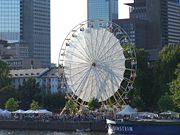
Festivals
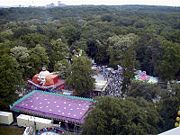
A major festival in the city is the Museumsuferfest (Museums Riverbank Festival). It is one of the biggest cultural festivals in Germany which attracts more than 3 million visitors over a period of 3 days. It takes place yearly at the end of August on both sides of the Main Riverbank in the city centre. More than 20 museums are located there and they are open far into the night. Furthermore there are special attractions like live-bands, dance shows, several booths for crafts, jewelry, clothes and food from all around the world. It ends with a spectacular firework display .
Frankfurt's oldest folk festival is the Dippemess (Festival of Stoneware) which takes place twice a year around Easter and the end of September in the eastern part of the city. Mentioned for the first time in the 14th century as an annual marketplace it is now more of an amusement park. ("Dippe" is a regional hessian dialect word meaning "pot" or "jar" and which would not be understood in most other German regions. The name of the festival derives from its original purpose, when it was a fair where traditionally crafted jars, pots and other stoneware were offered)
The Frankfurt Wäldchestag (Woods Day) is jocularly known as a regional holiday because until the 1990s it was common that Frankfurts shops were closed on this day. Despite the name the festival takes place over a period of four days after Pentecost with the actual Wäldchestag being Tuesday. What is special about this festival is its location in Frankfurt's city forest, south of the city centre in Niederrad.
The Wolkenkratzer Festival (Skyscraper Festival) is unique in Germany. It takes place irregularly, the last time in May 2007. For two days most of the skyscrapers in downtown Frankfurt are open to the public, which is normally not the case, apart from the Maintower observation deck. Around 1,2 million visitors took the opportunity to see the city from above. Sky-divers, base jumpers, fireworks and laser shows were extra attractions. The next festival will not be held before 2010.
The Sound of Frankfurt is a music festival held in the city centre. It took place regularly from 1994 to 2004 and is planned again for the summer of 2008. Various artists and bands performed open air and for free on eight stages located mainly around the Zeil. Different types of music (rock, Latino, house, alternative and pop) attracted about 500,000 visitors each year.
Foreign Culture
- Instituto Cervantes
Museums
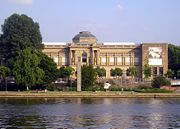
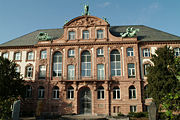
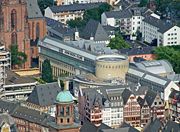
Most of the museums in Frankfurt are located on both sides of the River Main in Sachsenhausen (south side) and in the old part of the city centre (north side). The area is therefore known as Museumsufer (Museums Riverbank).
There are 13 museums on the south side between Eiserner Steg and Friedensbrücke, including:
- Ikonenmuseum
- Museum für Angewandte Kunst
- Museum der Weltkulturen
- Deutsches Filmmuseum
- Deutsche Architekturmuseum
- Museum für Kommunikation
- Städel, one of the most famous museums in Germany
- Liebieghaus
- Museum Giersch
The street itself, Schaumainkai, is partially closed to traffic on Saturdays for Frankfurt's largest flea market.
There are 2 museums on the north side:
- Jewish Museum Frankfurt
- Historisches Museum
Not directly located on the Riverbank are:
- Museum of Modern Art
- Schirn Kunsthalle (Schirn Art Gallery)
- Frankfurter Kunstverein founded in 1829
Another important museum is located in the Westend area:
- Senckenberg Natural History Museum, the largest natural history museum in Germany
Culinary specialties
- Frankfurter Sausage
- Frankfurter Rindswurst
- Apfelwein
- Grüne Soße
- Bethmännchen
- Frankfurter Kranz
- Handkäs mit Musik
- Rippchen mit Kraut
Dance music
The roots of trance music can be traced back to Germany, and in particular, Frankfurt. It was here, in the early 1990s, that local DJs like Sven Väth and DJ DAG (of Dance 2 Trance) first played a harder, deeper style of acid house, that became hugely popular worldwide, during the next decade. One of the main venues of the early Trance music sound was the Omen nightclub, in the city. Accordingly, some of the early, and most influential Trance acts, e.g. Jam and Spoon, Dance 2 Trance,Oliver Lieb and Hardfloor, and record labels such as Harthouse and Eye Q were based in the city, in the early 1990s.
Transport
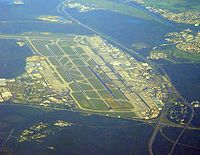
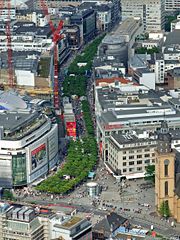


Airports
The city is accessed from around the world via the Frankfurt International Airport (Flughafen Frankfurt am Main) which is located 12 km (7 mi) from the city centre. The airport has three runways and serves 265 non-stop destinations. It ranks among the world's top ten airports and is the biggest cargo airport in Europe. Depending on whether total passengers or flights are used, it ranks as the second or third busiest in Europe alongside London Heathrow Airport and Paris Charles de Gaulle Airport. Passenger traffic at Frankfurt Airport in 2007 was 54.2 million. The airport can be reached by car or bus and has two train stations, one for regional and one for long-distance traffic. The S-Bahn lines S8 and S9 (direction "Frankfurt (Main) Hbf", "Offenbach Ost or "Hanau"), departing at the regional traffic station take 10-15 minutes from the airport to the Central Station and the city centre, the IC and ICE trains departing at the long-distance traffic station take as well 10-15 minutes.
Despite the name, Frankfurt Hahn Airport (Flughafen Frankfurt-Hahn) is not located anywhere near Frankfurt but is instead situated approximately 120 km (75 mi) from the city in Lautzenhausen (Rhineland-Palatinate). This airport can only be reached by car or bus. An hourly bus service runs from Frankfurt Central Station, taking about 1 hour and 45 minutes. Last year over 4 Million Passengers used this airport in order to use Low Cost Airlines like Ryanair.
Frankfurt Egelsbach Airport is a busy general aviation airport located south-east of Frankfurt International Airport, near the town of Egelsbach.
Roads
The streets of central Frankfurt are usually congested with cars during the rush hour. Some areas, especially around the shopping streets Zeil, are pedestrian-only streets. There are numerous car parks located throughout the city.
Frankfurt is a traffic hub of the German Autobahn system. The Frankfurter Kreuz is an Autobahn interchange close by the airport where the Autobahnen A 3 (Cologne-Würzburg) and A 5 (Basel-Hannover) meet. With approximately 320,000 cars daily it is the most heavily used interchange in Europe. The A 66 connects Frankfurt with Wiesbaden in the west and Fulda in the east. The A 661 starts in the south (Darmstadt), runs through the eastern part of Frankfurt and ends in the north (Bad Homburg). The A 648 is a very short Autobahn in the western part of Frankfurt.
Railway stations
Frankfurt Hauptbahnhof (or short Ffm Hbf) is the largest train station in Germany by number of platforms and railway traffic. Regarding daily passenger volume it ranks second together with München Hauptbahnhof (350,000 each) after Hamburg Hauptbahnhof (450,000). It is located between the Gallus and the Bahnhofsviertel, not far away from the Trade Fair and the financial district (Bankenviertel). It serves as a major hub for long-distance trains (ICE) and regional trains (all Rhine-Main S-Bahn lines, two U-Bahn lines, several tram and bus lines). Local trains are integrated in the Public transport system Rhein-Main-Verkehrsverbund (RMV), the second largest integrated public transport systems in the world. Only the Berlin integrated public transport system (VBB) is larger.
Frankfurt Airport Long Distance Station connects Frankfurt International Airport to the main rail network, most of the ICE services using the Cologne-Frankfurt high-speed rail line. It is one of two railway stations at the airport, the other is for local S-Bahn trains (lines S8 and S9), called Frankfurt Airport Regional Station.
The two major stations in the city centre are Hauptwache and Konstablerwache, both located on Frankfurts most famous shopping street, the Zeil.
Public transport
The city has two underground railway systems: the U-Bahn and the S-Bahn, as well as an above-ground tram system. Information about the U and S Bahn can be found on the RMV website.
Nine S-Bahn lines connect Frankfurt with the Rhine Main Region. All lines have a 30 minute service during the day but the majority of the routes are served by two lines thereby offering a 15 minute schedule. All lines, except line S7, run through the Frankfurt city tunnel and serve the stations Ostendstraße, Konstablerwache, Hauptwache, Taunusanlage and Frankfurt Central Station. When leaving the city the S-Bahn travels above ground. It provides access to the Frankfurt Trade Fair (S3-S6), the airport (S8, S9), the stadium (S7-S9) and nearby cities such as Wiesbaden, Mainz, Darmstadt, Rüsselsheim, Hanau, Offenbach am Main, Bad Homburg, Kronberg and smaller towns that are on the way.
The U-Bahn has seven lines serving the city centre and some larger suburbs. The trains that run on the line are in fact lightrails as many lines travel along a track in the middle of the street instead of underground further from the city centre. There is only one line (U4) that is completely underground. The minimum service interval is 2.5 minutes, although the usual pattern is that each line runs with a 7.5-10 minute frequency which combines to approx 3-5 minutes on the city centre sections served by more than one line.
Frankfurt has 9 tram lines, with trams arriving usually every 10 minutes. Many sections are served by two lines, combining to give a 5 minute frequency during rush-hour. The tram runs only above ground and serve more stops than the U-Bahn or the S-Bahn.
A number of bus lines complete the Frankfurt public transportation system. Night buses take over the service of the U-Bahn and tram at 1:30 am to 3:30 am on Friday and Saturday nights.
Taxis
Taxis can be found outside most S-Bahn or U-Bahn stations and major intersections. The normal way to obtain a taxi is to either call a taxi operator or go to a taxi rank. However, although not the norm, one can hail one on the street.
Bicycles
Deutsche Bahn also rent out bicycles to the public. One finds them at many major road intersections and railway stations. All one has to do is make a phone call to hire them for €0.06/min or they can be hired per day for €15,-. The bicycles are a bit heavy but they do have shock absorbers to ensure a smooth journey. The silver-red colour of the bikes with their unique frame make them easily visible and difficult to steal.
The public can now use a velotaxi which involves the operator using a tricycle with a sheltered passenger cab. There is room for two people and the service covers all of the city centre.
Frankfurt has also a network of modern cycle routes throughout city. Many of the long distance bike routes into town have dedicated cycle tracks. A number of city centre roads are "bicycle streets" where the cyclist has the right of way and where motorised vehicles are allowed access if they do not disrupt the cycle users.
Every first Sunday in the month there is a Critical Mass cycle event which starts at 2 pm at the Old Opera.
Economy and business
Frankfurt is one of the leading financial centres in Europe. According to an annual study (2007) by Cushman & Wakefield it is one of the top three cities for international companies in Europe, along with London and Paris. According to a ranking list (2001) produced by the University of Liverpool, Frankfurt is the richest city in Europe by GDP per capita. After Frankfurt are Karlsruhe, Paris and Munich [3]. The Mercer Human Resource Consulting Worldwide Quality of Living Survey 2007 ranked Frankfurt at the seventh position of the cities with the highest quality of life worldwide. The only German city that did better was Düsseldorf at number six [4].

Deutsche Bank Twin Towers
|

Eurotower, headquarters of the European Central Bank
|

Bull and Bear in front of the Frankfurt Stock Exchange
|
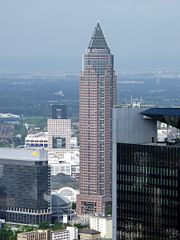
Messeturm at the exhibition centre
|
Banks
Frankfurt is commonly known as the city of the banks in Germany. It is sometimes referred to as Mainhattan (a portmanteau of the local river Main and Manhattan in New York City) or nicknamed Bankfurt. In 2006, six of the ten major German banks had their headquarters in the city, including the top four (Deutsche Bank, Commerzbank, Dresdner Bank and DZ Bank) [5]. Other important banks are ING Diba, KfW, BHF Bank, Bankhaus Metzler, Delbrück Bethmann Maffei, DekaBank, Landesbank Hessen-Thüringen and Frankfurter Sparkasse. More than 300 national and international banks are represented here [6].
The European Central Bank (Europäische Zentralbank) is one of the world's most important central banks, responsible for monetary policy covering the 15 member countries of the Eurozone. Since its foundation in 1998 the headquarters are located in downtown Frankfurt although plans have now been made for a move to a landscaped area on the site of the former wholesale market hall (Großmarkthalle) in the eastern part of the city.
The German Federal Bank (Deutsche Bundesbank) is an integral part of the European System of Central Banks (ESCB). It was established in 1957.
Stock exchange
With the stock exchange (Frankfurter Wertpapierbörse) and XETRA, which belong to Deutsche Börse, Frankfurt has the second largest stock exchange in Europe after the London Stock Exchange. It is by far the largest stock exchange in Germany with over 90 percent turnover in the German market. In terms of market capitalization, Deutsche Börse is the largest stock exchange in the world.
Trade fairs
Fairs have a very long tradition in Frankfurt. They were first mentioned in the 12th century. Today Frankfurt has the third-largest exhibition site in the world. The Messe Frankfurt corporation arranged 120 fairs in 40 countries in 2006. Hosted in Frankfurt are the Internationale Automobil-Ausstellung (the world's largest motor show), the Frankfurter Buchmesse (the world's largest book fair), the Ambiente (the world's largest consumer goods fair), the Achema (the world's largest plant engineering fair) and many more like Paperworld, Christmasworld, Beautyworld, Tendence Lifestyle or Light and Building.
Advertising agencies
Although it is best known for its banks, Frankfurt is also a centre for media companies. There are around 570 companies of the advertising industry and 270 public relations companies. According to a ranking of FOCUS magazine from November 2007 there are seven of the 48 largest advertising agencies in Germany based in Frankfurt, including Saatchi & Saatchi, JWT, and Publicis. Topping the list is Berlin with nine, followed by Hamburg with eight. After Frankfurt comes Munich with six. Wiesbaden is also on the list with two [7].
Accountancy and professional services
The Big Four, the four largest international accountancy and professional services firms, are all represented in Frankfurt.
They are Deloitte Touche Tohmatsu, Ernst & Young, KPMG and PricewaterhouseCoopers (PwC).
PwC has also its German headquarters in the city.
In October 2007, KPMG's member firms in the UK, Germany, Switzerland and Liechtenstein merged to form KPMG Europe LLP, which is now the largest accountancy and professional services firm in Europe. The European headquarters will be situated in Frankfurt.
Management consulting
Some of the largest international management consulting firms are represented in Frankfurt, including Accenture, McKinsey & Company, Boston Consulting Group, Booz & Company, Oliver Wyman, Bain & Company and Roland Berger Strategy Consultants.
Electronic communication
Frankfurt is also an important location for the internet. It is home to Germany's largest internet exchange point, DE-CIX, and is where domain names are registered for the top-level-domain ".de".
Lawyers
Frankfurt has the highest concentration of lawyers in Germany, with one lawyer per 99 inhabitants. Most of the large international law firms maintain offices in Frankfurt, among them Baker & McKenzie, Clifford Chance, Cleary Gottlieb Steen & Hamilton, Debevoise & Plimpton, Mayer Brown, Norton Rose, Shearman & Sterling, and Taylor Wessing.
Working in Frankfurt
With over 922 jobs per 1,000 inhabitants, Frankfurt has the highest concentration of jobs in Germany. The high number of around 600,000 jobs with only 663,000 inhabitants of the city itself is explained by the high number of commuters who work in the city, which raises the per capita GDP of the resident population significantly. On work days and Saturdays there are around one million people within the city limits. On other days, the statistics regarding Frankfurt's wealth are reduced, in favor of the communities and towns of the so-called "Speckgürtel" (literally bacon belt, meaning the suburban area), such as Bad Homburg, Königstein im Taunus, Kronberg im Taunus and Bad Soden am Taunus, many of whose inhabitants work in Frankfurt.
Despite that, Frankfurt also had, as of 2003, the highest levels of crime per 100,000 inhabitants in Germany. However, this statistic is a result of the commuter population, for it is calculated based on the 650,000-inhabitant figure, and also includes crimes committed at the airport, such as smuggling. Frankfurt is actually therefore a very safe city, corroborated by surveys among the inhabitants.
Frankfurt International Airport is the single largest place of work in Germany.
Other businesses
Frankfurt is home to chemical industries, software businesses and call centers. Business development and other important departments of the Deutsche Bahn are located at the DB-Headquarters in Gallus. Because of Hoechst AG, Frankfurt is considered the "Apothecary of the World". Höchst's industrial park in Frankfurt is one of the three largest locations for the chemical and pharmaceutical industry in Europe. Frankfurt is also home to several large German industrial associations, such as the Chemical Industry Association; the Association for German Machine- and Equipment-building; the Electrotechnical, Electronic, and Information Technology Association e. V. with its affiliated electrotechnical standards commission; and the Association of German Automobile Producers, which is currently moving to Franfurt. The Union of German Automobile Producers meets in Frankfurt every two years to coincide with the International Automobile Exhibition, mentioned above. Furthermore, the Trade Association of German Booksellers has its headquarters in Frankfurt, and organizes the Frankfurt Book Fair. In terms of labor unions, Frankfurt is home to the headquarters of IG Metall and IG Bau, two of Germany's largest labor unions.
Businesses with regional headquarters or based in and near Frankfurt include:
|
Property and real estate
Frankfurt has the highest concentration of home owners in Germany. This is partly attributed to number of financial workers in the city but also because of its cosmopolitan nature with a quarter of the city's population being foreigners. For this reason Frankfurt's property market often operates differently than the rest of the country where the prices are generally much flatter than Frankfurt. German property prices are pulled down nationally because of the former East Germany, however, economically sound cities like Frankfurt and other cities in the west of Germany, have a buoyant housing market, which attracts a lot of buyers from the Far East.
Establishments and organization
Frankfurt is home of the German National Library, the Hessian State Supreme Court, and the Hessian State Employment Court, and has its own police academy. The fire department, founded in 1874, and the volunteer fire department have eight fire stations. Until their dissolution at the end of 2003, Frankfurt was the location of the Federal Disciplinary Court.
The German office of the International Finance Corporation, part of the World Bank group, and the Committee of European Insurances and Occupational Pensions Supervisors (Ceiops), the European insurance control, have their headquarters in Frankfurt.
Frankfurt hosts 88 consulates. Only New York and Hamburg have more foreign representation, excluding capital cities. Russia and China have recently opened general consulates in Frankfurt. The Consulate General of the United States in Frankfurt in Eckenheim is the largest American consulate in the world.
Media

Two important daily newspapers are published in Frankfurt. The conservative Frankfurter Allgemeine Zeitung was founded in 1949 and is the German newspaper with the widest circulation abroad, with its editors claiming to deliver the newspaper to 148 countries every day. The FAZ has a circulation of over 380,000 copies daily. The other important newspaper, the Frankfurter Rundschau, was first published in 1945 and has a daily circulation of over 181,000 copies.
Frankfurt is also home to the German headquarters of Reuters, one of the world's most important news agencies.
Several magazines also originate from Frankfurt. The Journal Frankfurt is the best-known magazine for events, parties, and "insider tips". An "ecological magazine", Öko-Test, publishes materials for the Green Party of Germany in Bockenheim. Bockenheim is known for the quiz magazine of the same name, and is home to the editorial office of the satire magazine, Titanic.
Frankfurt's first radio station was the Südwestdeutsche Rundfunkdienst AG (Southwest German Radio Service), founded in 1924. Its successor service is the public broadcaster Hessischer Rundfunk (Hessian Broadcast). Its "Funkhaus am Dornbusch" station is one of the most important radio and television broadcasters. There is also the ARD-Stern that broadcasts from individual senders via a high-service network. Bloomberg TV and RTL have regional studios on the Neuen Mainzer Straße, downtown. Other broadcasters in Frankfurt include Main FM and Radio X. The largest private radio station in the region FFH, is located nearby in Bad Vilbel.
Since August 1945, the American Forces Network had broadcasted from Frankfurt. Due to troop reductions, the AFN's Frankfurt location has been abandoned. Since October 2004, the AFN has broadcast its European programs from Mannheim.
Education and research
In Frankfurt am Main, there are two universities and several specialist schools.
Johann Wolfgang Goethe University
The oldest and most well-known university in the city is the Johann Wolfgang Goethe University, with locations in Bockenheim, Westend, and Riedberg, and the university hospital in Niederrad.
Frankfurt University of Applied Sciences
The Frankfurt University of Applied Sciences (Fachhochschule Frankfurt am Main) was created out of several older organizations in 1971, and offers over 38 study areas, in the arts, sciences, engineering and law. Some of the most important research projects: Planet Earth Simulator, Fraline-IT-School-Service, quantitativ analysis of methan in human corpses with the help of a mass spectrometer, Softwareengeneering (e.g. fraDesk), analysis of qualitative and quantitative gas in human lungs, long-term studies on photovoltaicmodules (only to name a few).
Frankfurt School of Finance & Management
Alongside the university is the banking academy Frankfurt School of Finance & Management, formerly known as the Hochschule für Bankwirtschaft (Institution of Higher Learning for Banking Economics), with its campus in the Ostend (Eastend) neighborhood. Since 2001, it has been a specialist institution for the teaching Economics and Management, or FOM.
Städelschule and Conservatories
Frankfurt has the State Institution of Higher Learning for Artistic Education known as the Städelschule, founded in 1817 by Johann Friedrich Städel, that was taken over by the city in 1942 and turned into a state art school. Other music institutions are the Frankfurt University of Music and Performing Arts, and the Dr. Hoch's Konservatorium which was founded in 1878.
Other notable schools
Until September 2003, Frankfurt was also home to a school for library science and administration.
The Philosophical-Theological Institution of Saint George (Philosophisch-Theologische Hochschule Sankt Georgen, a private institution with membership in the German Jesuit Association, has been located in Sachsenhausen since 1950.
The city is also home of three Max Planck Society institutes: the Max Planck Institute for European Legal History (MPIeR), Max Planck Institute for Biophysics, and the Max Planck Institute for Brain Research.
The Frankfurt Institute for Advanced Studies, sponsored by several institutional and private sources, is involved in theoretical research in physics, chemistry, neuroscience, and computer science.
Frankfurt is host to the Römisch-Germanische-Kommission (RGK), the German Archaeological Institute branch for prehistoric archaeology in Germany and Europe. The RGK is involved in a variety of research projects. Its library, with over 130,000 volumes, is one of the largest specialised archaeological libraries in the world.
Education and media
Over the past years the city of Frankfurt has been increasingly investing into the IT-infrastructure of its schools. As a result, schools in Frankfurt now rank among the best equipped schools nationwide as far as availability of PCs and other media facilities are concerned. In order to assure maintenance and support of the school PCs, the city of Frankfurt in cooperation with the University of Applied Sciences has launched the project Fraline - IT-Schul-Service, an initiative employing students to provide basic school IT-support.
Sport
Frankfurt hosts the following sports teams or clubs:
|
|
|
Frankfurt used to host these former teams or clubs:
|
|
Frankfurt is host to the classic cycle race Rund um den Henninger-Turm.
Twin Towns - Sister Cities
Frankfurt twinned with, or has sister city relationships with:[8]
|
 Deuil-la-Barre in France, partnered with Nieder-Eschbach (Frankfurt am Main) (since 1967; incorporated in 1972)
Deuil-la-Barre in France, partnered with Nieder-Eschbach (Frankfurt am Main) (since 1967; incorporated in 1972)
Gallery
See also
- Free City of Frankfurt
- Frankfurt Trade Fair
- Frankfurt Book Fair
- Frankfurt Conservatory - Music Academy
- Frankfurt Transit
- Frankfurt School
- List of mayors of Frankfurt
References
- ↑ 1.0 1.1 (English) "World Urban Areas" (PDF). Retrieved on 2007-09-20.
- ↑ "World Cities". Retrieved on 2007-01-23.
- ↑ Nick Swift: European cities outperform their English counterparts. citymayors.com (Zugriff am 1. November 2006)
- ↑ Highlights from the 2007 Quality of Livings – Mercer Human Resource Consulting
- ↑ The Top 100 German banks 2006
- ↑ Wirtschaft in Frankfurt am Main
- ↑ FOCUS: Die größten Werbeagenturen 2007
- ↑ "Frankfurt -Partner Cities". © 2008 Stadt Frankfurt am Main. Retrieved on 2008-12-05.
- ↑ "Milano - Città Gemellate". © 2008 Municipality of Milan (Comune di Milano). Retrieved on 2008-12-05.
- Frankfurt — City Guide, Kraichgau Verlag (ISBN 3-929228-21-1)
External links
- Official website
- Frankfurt travel guide from Wikitravel
- Architecture of Frankfurt
- Frankfurt Zoo (English)
- Frankfurt Panoramas: [1], [2], [3], [4]
- Frankfurt before and after World War II
- Frankfurt webcam links
- Frankfurt photogallery
- Visual Frankfurt
 |
Hochtaunuskreis | Wetteraukreis |
|
||||
| Main-Taunus-Kreis | Main-Kinzig-Kreis | ||||||
| Groß-Gerau | Offenbach (district) | Offenbach (city) |
|
||||||||